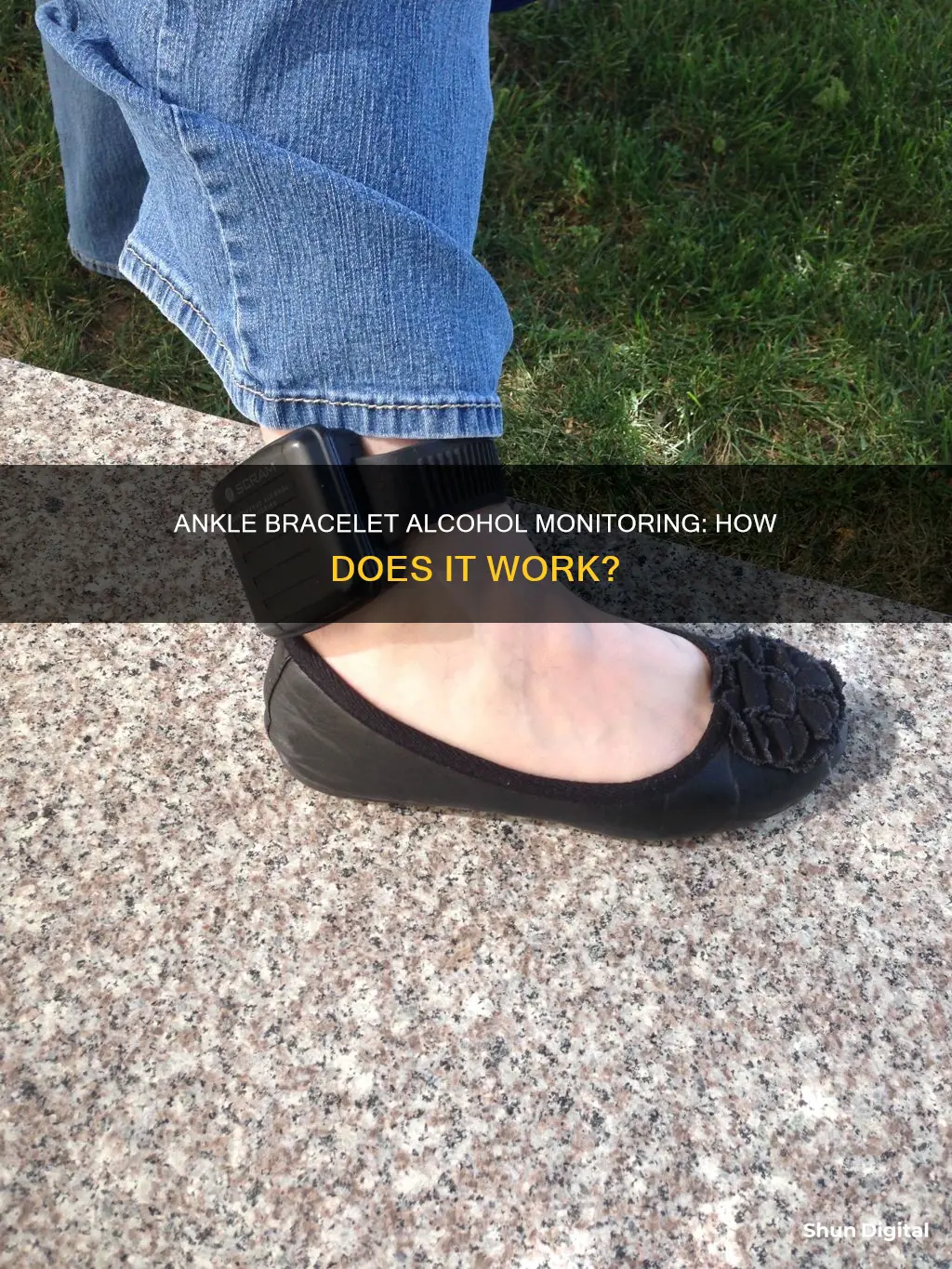
Alcohol-monitoring ankle bracelets, also known as SCRAM bracelets, are used to monitor the blood alcohol concentration of the wearer. SCRAM stands for 'Secure Continuous Remote Alcohol Monitor'. The bracelet is fitted to the individual's ankle and tests their perspiration for alcohol every 30 minutes. This is known as transdermal alcohol testing, where a small portion of consumed alcohol is excreted through the skin via perspiration. The readings are then transmitted to a base station and monitored by a private company, who will notify the court or probation officer if the wearer is found to be drinking alcohol.
| Characteristics | Values |
|---|---|
| Name | SCRAM bracelet, short for Secure Continuous Remote Alcohol Monitor |
| Weight | Lightweight, approximately 8 oz |
| Form | Ankle bracelet |
| Purpose | Monitor wearer's blood alcohol concentration |
| Testing | Tests wearer's perspiration every 30 minutes |
| Technology | Electrochemical fuel cell |
| Data transmission | Wireless |
| Alerts | Sent to a regional monitoring centre, court or probation officer |
| Tamper-proof | Equipped with temperature and infrared sensors, security screw and tamper-proof clasp |
| Waterproof | No, alarms are triggered if submerged in water |
| Installation fee | $50-$100 |
| Daily monitoring fee | $10-$20 |
What You'll Learn

How SCRAM bracelets work
SCRAM bracelets are an innovative way to monitor alcohol consumption. They are typically fitted to an individual's ankle and worn for 30, 60, or 90 days, or in some cases, for a year or longer. These bracelets are often court-ordered for DUI offenders and other cases involving alcohol and substance abuse.
The SCRAM bracelet, short for Secure Continuous Remote Alcohol Monitor, is a lightweight device that tracks the wearer's blood alcohol concentration by measuring their perspiration every 30 minutes. This system employs the same fuel cell technology as portable breath-testing devices, reacting with ethanol to measure blood alcohol content. However, instead of breathing into the system, the bracelet samples the wearer's sweat to detect alcohol.
The bracelet automatically takes sweat samples and transmits the data to a base station, which then uploads the information to monitoring software. This continuous monitoring eliminates testing gaps and helps maintain accountability. It also distinguishes between alcohol consumption and environmental sources of alcohol, such as perfumes or hand sanitizers.
In addition to alcohol detection, SCRAM bracelets are equipped with advanced anti-tampering technology. They feature temperature and infrared sensors that detect any attempts to obstruct or remove the device. If someone tries to tamper with the bracelet, the monitoring company and the court or probation department are immediately notified.
The use of SCRAM bracelets has been proven to support long-term behaviour change and complement treatment for alcohol dependence. They provide a way to ensure compliance with court orders and enhance community safety.
Ways to Measure Your Monitor's Width
You may want to see also

SCRAM bracelets' accuracy
SCRAM (Secure Continuous Remote Alcohol Monitoring) bracelets are considered by courts to be scientifically accurate and reliable for transdermal alcohol monitoring. They are often used as punishments imposed after conviction for alcohol-related offences.
The technology behind SCRAM bracelets has progressed rapidly over recent years, but the basic mechanism uses transdermal alcohol testing to evaluate the presence of alcohol in the wearer's body. The bracelets test the wearer's perspiration for alcohol every 30 minutes. When a person drinks alcohol, a certain amount will be metabolized and emitted as sweat through the skin. The bracelets contain sensors that use transdermal alcohol testing technology, which measures the amount of alcohol vapour emitted through the skin.
SCRAM bracelets are also equipped with anti-tampering technology. They have temperature and infrared sensors that can detect attempts to obstruct or remove the device. For example, if the battery is removed and reinserted, the bracelet will detect this. There is also a small electrical signal that passes through the strap, so if the strap is cut, the electrical signal will be interrupted.
However, despite the advancements in SCRAM technology, false positives remain a possibility. False positives occur when the bracelet incorrectly indicates that the wearer has consumed alcohol when they have not. This can be caused by the presence of alcohol in consumer goods such as hairspray, lotions, mouthwash, and even kombucha. While it would take a large amount of these products to trigger a false positive, spending multiple hours in a hair salon, for example, could cause a false positive.
In addition, SCRAM bracelets cannot confirm complete abstinence from alcohol. Even low alcohol consumption (1-2 units) can be detected by the bracelet.
The Evolution of LCD Monitors: A Historical Perspective
You may want to see also

Who monitors SCRAM bracelets
SCRAM bracelets, or Secure Continuous Remote Alcohol Monitoring bracelets, are often court-ordered for offenders who aren't supposed to be drinking alcohol, especially in cases of driving under the influence (DUI) or driving while intoxicated (DWI). Courts can also order SCRAM bracelets in other types of cases involving drug and alcohol use, such as family court, domestic violence, underage drinking, and substance abuse cases.
The bracelets are fitted and removed by trained professionals, such as Lextox Collectors, who will also install the SCRAM Base Station. The bracelets are typically worn for 30, 60, or 90 days, but in some cases, they may be worn for a year or longer as a term of probation or parole. Offenders must wear them 24/7, and they are designed to detect any kind of tampering. If an offender attempts to remove the bracelet, the monitoring company will be notified, and they will report the tampering to the court or the probation department.
The SCRAM bracelets work by monitoring the wearer's perspiration every 30 minutes. When a person drinks alcohol, a certain amount will be metabolized and excreted through the skin in the form of sweat. The bracelets detect the presence of alcohol in the sweat and transmit this data to a regional monitoring centre, such as the SCRAM Wireless Base Station. If the wearer's sweat contains alcohol, or if the bracelet is tampered with, the monitoring centre will notify the appropriate authorities.
The data transmitted by the SCRAM bracelets is subject to rigorous analysis by a team of professionally trained analysts. The confirmation criteria used by these analysts are peer-reviewed, validated, and published. The SCRAM bracelet technology is also single-source admissible, meaning no secondary tests are required to validate the results. The company that manufactures the bracelets, SCRAM Systems, provides court testimony support and has participated in evidentiary hearings around the country.
Water Usage Monitoring in California: How Does It Work?
You may want to see also

What happens if you try to remove a SCRAM bracelet
SCRAM bracelets, or Secure Continuous Remote Alcohol Monitoring bracelets, are court-ordered alcohol-monitoring ankle bracelets. They are often used in DUI cases and other cases involving drugs and alcohol, such as family court, domestic violence, underage drinking, and substance abuse cases. These bracelets are designed to detect alcohol consumption and any kind of tampering with the bracelet itself.
If an individual attempts to remove a SCRAM bracelet, the company monitoring the device will receive a notification and report the tampering to the court or the probation department. Tampering with a SCRAM bracelet can lead to severe consequences for the offender, such as termination of probation, jail time, or other penalties deemed appropriate by the court. The act of removing the bracelet is considered a violation of the terms of the monitoring program and will be treated as such by the court.
It is important to note that SCRAM bracelets are equipped with advanced anti-tamper technology. They can detect various indicators of tampering, including attempted removal, obstruction of the sensor, or any interference with the device's functionality. The bracelets also have temperature and infrared sensors that can detect attempts at tampering or obstruction. Therefore, it is highly unlikely that an individual will be able to remove the bracelet without being detected.
In addition, while it is physically possible to cut off a SCRAM bracelet, as they are designed to be easily removed in case of emergencies, doing so will almost certainly trigger an alarm. The bracelet contains a radio transmitter that sends a distress signal when tampered with, and cutting the bracelet may break a circuit, immediately sending an alert to the authorities. As such, it is extremely difficult to remove a SCRAM bracelet without being caught and facing the associated consequences.
Ways to Check Your Monitor's FPS Capacity
You may want to see also

Drawbacks of SCRAM bracelets
While SCRAM bracelets are widely used and have proven effective in monitoring alcohol consumption, there are some drawbacks and limitations to consider.
One drawback of SCRAM bracelets is the potential invasion of privacy. Although they are often imposed as a condition of probation or parole, some may argue that the continuous monitoring of an individual's alcohol consumption through their perspiration is a violation of civil liberties. This monitoring can be seen as an intrusion into personal space and daily activities, even if it is done remotely.
Another drawback is the cost associated with SCRAM bracelets. Defendants are typically charged a one-time installation fee, which can range from $50 to $100, and a daily monitoring fee of around $10 to $15. These fees can quickly add up, resulting in monthly costs of $450 or more. For individuals already facing financial challenges, these additional expenses can be a significant burden.
In terms of limitations, SCRAM bracelets are designed specifically to detect ethyl alcohol, which is found in alcoholic beverages. However, they may not always differentiate between alcohol consumption and exposure to external environmental sources of alcohol, such as hand sanitizers, perfumes, or cleaning agents. While SCRAM technology aims to distinguish between ingested and environmental alcohol, false positives can still occur due to factors beyond an individual's control.
Additionally, while SCRAM bracelets are highly accurate, they cannot confirm complete abstinence from alcohol. Even low alcohol consumption of 1-2 units can be detected, but the bracelets do not provide a precise measurement of blood alcohol content. This lack of specificity may be a limitation in certain legal or medical contexts.
Furthermore, SCRAM bracelets are intended to be worn for an extended period, typically 30, 60, or 90 days, and must be worn 24/7 during this time. This prolonged wear may cause discomfort or skin irritation for some individuals, impacting their daily activities and quality of life.
Lastly, while SCRAM bracelets are designed to be tamper-proof, there is still a risk of circumvention or interference. Although the bracelets have anti-tamper technology, individuals may attempt to find ways to disable or trick the device, which can lead to legal repercussions if discovered.
LCD Monitor: Does Nikon 3500 Have One?
You may want to see also
Frequently asked questions
SCRAM stands for Secure Continuous Remote Alcohol Monitor. It is an ankle bracelet that measures the wearer's blood alcohol concentration by testing their perspiration every 30 minutes.
The bracelet uses transdermal alcohol testing, which means it detects alcohol excreted through the skin. It reacts with ethanol in the wearer's perspiration to measure their blood alcohol content.
Courts often order SCRAM bracelets in DUI cases and other cases involving drugs and alcohol. They are typically worn by multiple-time drunk driving offenders, domestic violence offenders where alcohol is a factor, parents in family court, and underage drinkers.
SCRAM bracelets are designed with anti-tamper technology, including temperature sensors and infrared sensors. If you attempt to remove or tamper with the bracelet, the monitoring company will be notified and this will be reported to the court or probation department. Tampering with a SCRAM bracelet can result in severe consequences such as termination of probation or jail time.
Some drawbacks of SCRAM bracelets include discomfort and skin irritation. They are also not waterproof, so swimming is not allowed. Individuals must also refrain from using products with alcohol, such as mouthwash, perfumes, and certain lotions, to avoid false alcohol reports.







